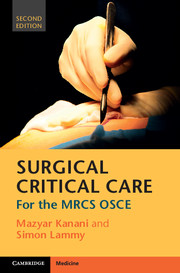2 - Breathing
from Section 1 - Ward care (level 0–2)
Published online by Cambridge University Press: 05 July 2015
Summary
Assessment
Respiratory assessment
Which basic investigationsmay be used in assessing respiratory function?
Following basic clinical examination of the chest during a respiratory examination, investigationsmay include
Non-invasive
Peak expiratory flow rate (PEFR): a bedside measure of the airway resistance and respiratory muscle function
Pulse oximetry:measures arterial oxygen saturation (SaO2) and heart rate
Capnography:measures end-tidal CO2 as a marker of ventilatory function
Pulmonary function tests (PFTs)
▪ Spirometry, to measure lung volumes charted on a Vitalograph®, e.g. functional expiratory volume in 1 second (FEV1) and functional vital capacity (FVC). The FEV1/FVC is a measure of airflow limitation and is normally>80%. Other tests include total lung capacity (TLC) and residual volume (RV). These are useful in patients who have obstructive lung disease, e.g. asthma and COPD
▪ Gas transfer, a measure of the diffusing capacity across the lung, e.g. transfer factor (DLco), which measures the transfer of low carbon monoxide concentrations in inspired air to haemoglobin, and transfer coefficient (Kco), which is the DLco corrected for alveolar volume
Microbiology analysis: of sputum and retained secretions, including culture and cytology
V/Q scanning: if pulmonary emboli are suspected
Echocardiography: to assess pulmonary artery pressure and right heart function in cases of pulmonary hypertension and cor pulmonale
Radiology: plain chest radiography, high-resolution CT, MRI
Invasive
Arterial blood gas (ABG) analysis: directly measures oxygenation (PaO2), ventilation (PaCO2) and acid–base balance
Bronchoscopy:may be flexible or rigid
Lung biopsy:may be performed through a CT-guided approach or video-assisted thoracoscopic surgery (VATS).
Rare cases may dictate an open operation
Mediastinoscopy: performed through an incision at the root of the neck, permitting biopsies of regional tracheobronchial lymph nodes for staging pulmonary or oesophageal malignancy
Pulmonary positron emission tomography (PET): is a gold standard diagnostic procedure for evaluating the structure and function of pulmonary lesions, e.g. nodules or emboli
What are the applications of flexible (fibre optic) bronchoscopy?
The applications may be both diagnostic and therapeutic
Direct visualisation of the tracheobronchial tree in cases of obstruction, e.g. retained secretions during atelectasis and aspiration of gastric contents. It may be performed through the endotracheal tube in the mechanically ventilated patient
Biopsy for cytology or histology, which may be obtained by direct sampling or by brushings and bronchoalveolar lavage (BAL), e.g. during suspected malignancy or infection
- Type
- Chapter
- Information
- Surgical Critical CareFor the MRCS OSCE, pp. 21 - 68Publisher: Cambridge University PressPrint publication year: 2015



